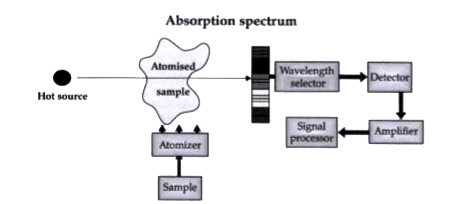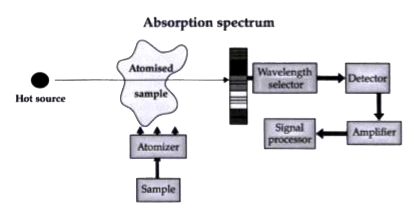The dye acriflavine when dissolved in water has its maximum light absorption at 4530 Ã… and has maximum fluorescence emission at 5080 Ã…. The number of fluorescence quantum is, on the average, 53% of the number of quanta absorbed. What percentage of absorbed light energy is emitted as fluorescence?
41%
47%
74%
63%
The correct Answer is:B
Energy of each photon absorbed
E=hv=hvλ
E=6.63×10−34Js×3×108m/s4530×10−10m
=4.39×10−19 J
Energy of each photon emitted E=hv=hvλ
=6.63×10−34Js×3×108m/s5080×10−10m
=3.92×10−19 J
Energy fraction emitted
=0.53(3.92×10−19)4.39×10−19×100=47%
Topper's Solved these Questions
- BOOK - DINESH PUBLICATIONCHAPTER - CHEMICAL BONDING AND MOLECULAR STRUCTUREEXERCISE - Brain Teaser-240videos
CHEMICAL BONDING AND MOLECULAR STRUCTURE
- BOOK - DINESH PUBLICATIONCHAPTER - CHEMICAL BONDING AND MOLECULAR STRUCTUREEXERCISE - Unit Test - 120videos
CHEMICAL BONDING AND MOLECULAR STRUCTURE
- BOOK - DINESH PUBLICATIONCHAPTER - CHEMICAL BONDING AND MOLECULAR STRUCTUREEXERCISE - Ultimate Preparatory Package20videos
CHEMICAL BONDING AND MOLECULAR STRUCTURE
- BOOK - DINESH PUBLICATIONCHAPTER - CARBOXYLIC ACIDS EXERCISE - BRAIN STORMING MULTIPLE CHOICE QUESTIONS (MCQS)13videos
CARBOXYLIC ACIDS
- BOOK - DINESH PUBLICATIONCHAPTER - CHEMICAL KINETICSEXERCISE - Additional Numerical Problems For Practice16videos
CHEMICAL KINETICS
Similar Questions
A certain dye absorbs light of λ=4530Å and then fluorescence light o 5080Å. Assuming that under given conditioins 47% of the absorbed energy is re emitted out as fluorescence. Calculate the ratio of quanta emitted out to the number of quanta absorbed.
View SolutionA certain dye absorbs 4000 Å and fluoresces at 8000 Å. These being wavelengths of maximum absorption that under given conditions 50 % of the absorbed energy is emitted. Calculate the ratio of the no. of quanta emitted to the number absorbed.
View Solution
Knowledge Check
- Question 1 - Select One
A certain dye absorbs light of λ=4000Å and then flurescences light of λ=5000Å . Assuming that under given conditions 50 % of the absorbed energy is re-emitted out as fluorescence , calculate the ratio of the number of quanta emitted out to the number of quanta absorbed :
A58B85C38D83 - Question 2 - Select One
A certain dye absorbs light of λ=4000Å and then fluresces light of 5000Å. Assuming that under given conditions 50% of the absorbed energy is re-emitted out as fluorescence, calculate the ratio of number of quanta emitted out to the number of quanta absorbed.
A58B85C38D83 - Question 3 - Select One
Read the following text and answer the following questions on the basis of the same:
Atomic Absorption Spectrometer: The atomic absorption (AA) spectrometer is used to analyze metals at very low concentrations, typically in the parts per million (ppm) or parts per billion (ppb) ranges. A liquid sample containing dissolved material whose concentration is to be measured is aspirated into a thin, wide AA flame, or is introduced into a small carbon furnace which is heated to a high temperature.

Basic Principle of AAS is the measurement of absorption of radiation by free atoms. The total amount of absorption depends on the number of free atoms present and the degreee to which the free atoms absorb the radiation. At the high temperature of the AA flame, the sample is broken down into atoms using an atomizer and it is the concentration of these atoms that is measured. Sample in the form of solution is used. It is broken up into a fine mist with the help of an atomizer. When the mist reaches the flame, the intense heat breaks up the sample into its individual atoms. When a photon coming out from the hot source hits an atom and the energy of the photon is equal to the gap between two electron energy levels of the atom, then the electron in the lower energy level absorb the photon and jumps up to the higher energy level. If the photon energy does not correspond to the difference between two energy levels, then the photon will not be absorbed (it may be scattered away). Hence in the spectrum, the wavelength corresponding to the absorbed photons is observed as black lines as shown in the following spectrum of Hydrogen. The dark lines correspon to the frequencies of light those have been absorbed by the sample element. Using this process, a source of photons (generally a white light) of various energies is used to obtain the absorption spectra of different materials and to identify them.
What happens when a photon hits an atom and the energy of the photon is not equal to the gap between two electron energy levels of the atom?AThe photon is absorbed and the electron moves to an intermediate energy level.BThe photon is absorbed and the electron gets scatteredCThe photon is not absorbed. It gets scattered.DNone of the above
A certain day absorbs lights of λ=400 nm and then fluorescence light of wavelength 500 mn. Assuming that under given condition 40% of the absorbed energy is re-emitted as fluorescence, calculate the ratio of quanta obserbed to number of quanta emitted out.
View SolutionA certain dye absorbs 4530A∘ and fluoresence at 5080A∘ these being wavelength of maximum absorption that under given condition 47% of the absorbed energy is emitted. Calculate the ratio of the no of quanta emitted to the number absorbed.
View SolutionA dye obsorbs light of λ=4530Å and then flaorescences light of 5000Å .Assuming that uinder given condition 47% of the obserbed energy is re-emited out so flaurescence , calculate the ratio of quants emitted out to the number of quanta obserbed
View SolutionRead the following text and answer the following questions on the basis of the same:
Atomic Absorption Spectrometer: The atomic absorption (AA) spectrometer is used to analyze metals at very low concentrations, typically in the parts per million (ppm) or parts per billion (ppb) ranges. A liquid sample containing dissolved material whose concentration is to be measured is aspirated into a thin, wide AA flame, or is introduced into a small carbon furnace which is heated to a high temperature.

Basic Principle of AAS is the measurement of absorption of radiation by free atoms. The total amount of absorption depends on the number of free atoms present and the degreee to which the free atoms absorb the radiation. At the high temperature of the AA flame, the sample is broken down into atoms using an atomizer and it is the concentration of these atoms that is measured. Sample in the form of solution is used. It is broken up into a fine mist with the help of an atomizer. When the mist reaches the flame, the intense heat breaks up the sample into its individual atoms. When a photon coming out from the hot source hits an atom and the energy of the photon is equal to the gap between two electron energy levels of the atom, then the electron in the lower energy level absorb the photon and jumps up to the higher energy level. If the photon energy does not correspond to the difference between two energy levels, then the photon will not be absorbed (it may be scattered away). Hence in the spectrum, the wavelength corresponding to the absorbed photons is observed as black lines as shown in the following spectrum of Hydrogen. The dark lines correspon to the frequencies of light those have been absorbed by the sample element. Using this process, a source of photons (generally a white light) of various energies is used to obtain the absorption spectra of different materials and to identify them.
What is the basic principle of Atomic Absorption Spectrophotometer?View SolutionRead the following text and answer the following questions on the basis of the same:
Atomic Absorption Spectrometer: The atomic absorption (AA) spectrometer is used to analyze metals at very low concentrations, typically in the parts per million (ppm) or parts per billion (ppb) ranges. A liquid sample containing dissolved material whose concentration is to be measured is aspirated into a thin, wide AA flame, or is introduced into a small carbon furnace which is heated to a high temperature.

Basic Principle of AAS is the measurement of absorption of radiation by free atoms. The total amount of absorption depends on the number of free atoms present and the degreee to which the free atoms absorb the radiation. At the high temperature of the AA flame, the sample is broken down into atoms using an atomizer and it is the concentration of these atoms that is measured. Sample in the form of solution is used. It is broken up into a fine mist with the help of an atomizer. When the mist reaches the flame, the intense heat breaks up the sample into its individual atoms. When a photon coming out from the hot source hits an atom and the energy of the photon is equal to the gap between two electron energy levels of the atom, then the electron in the lower energy level absorb the photon and jumps up to the higher energy level. If the photon energy does not correspond to the difference between two energy levels, then the photon will not be absorbed (it may be scattered away). Hence in the spectrum, the wavelength corresponding to the absorbed photons is observed as black lines as shown in the following spectrum of Hydrogen. The dark lines correspon to the frequencies of light those have been absorbed by the sample element. Using this process, a source of photons (generally a white light) of various energies is used to obtain the absorption spectra of different materials and to identify them.
What should be the concentration of metal for analysis using Atomic Absorption Spectrometer?View Solution

